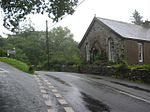Pensarn railway station
DfT Category F2 stationsFormer Cambrian Railway stationsLlanfair, GwyneddRailway request stops in Great BritainRailway stations in Great Britain opened in 1867 ... and 4 more
Railway stations in GwyneddRailway stations served by Transport for Wales RailUse British English from July 2015Wales railway station stubs

Pensarn railway station serves the village of Pensarn in Gwynedd, Wales. The station is an unstaffed halt on the Cambrian Coast Railway with passenger services to Porthmadog, Pwllheli, Barmouth, Machynlleth and Shrewsbury. The station opened as Pensarn but on 1 April 1885 it was renamed Llanbedr and Pensarn (Welsh: Llanbedr a Phensarn) and then on 8 May 1978 it reverted to its original name of Pensarn. Most trains call only on request. Abergele and Pensarn railway station is on the North Wales Coast Line.
Excerpt from the Wikipedia article Pensarn railway station (License: CC BY-SA 3.0, Authors, Images).Pensarn railway station
A496,
Geographical coordinates (GPS) Address Nearby Places Show on map
Geographical coordinates (GPS)
| Latitude | Longitude |
|---|---|
| N 52.830248 ° | E -4.110966 ° |
Address
A496
LL45 2HP , Llanfair
Wales, United Kingdom
Open on Google Maps










